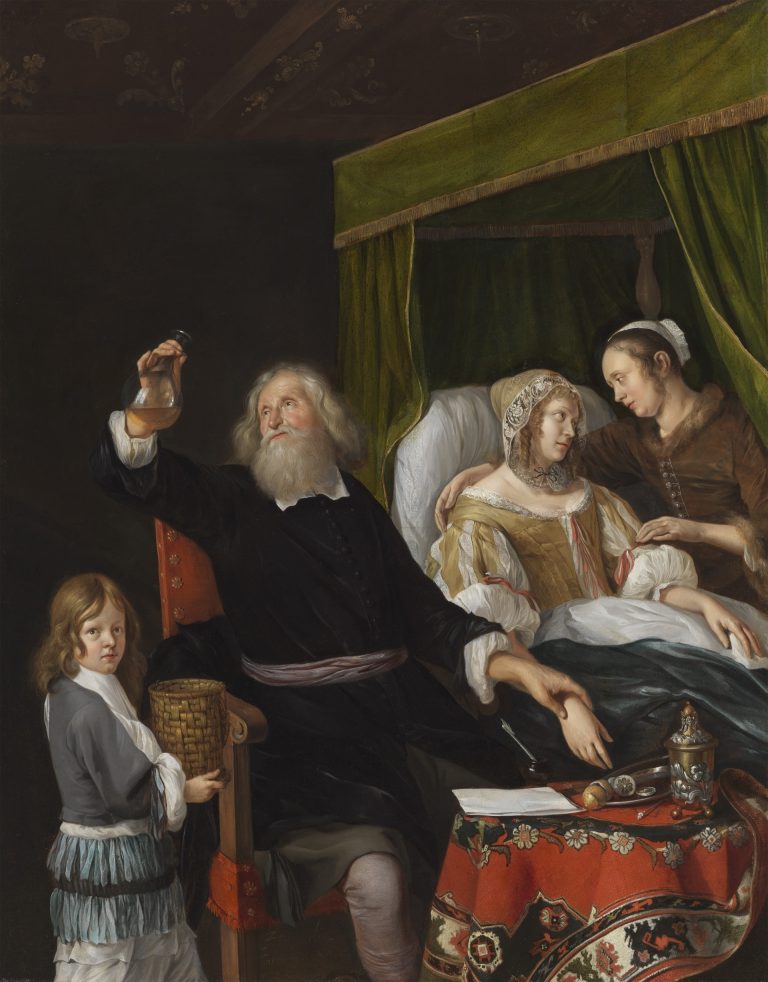This splendid picture is one of the finest of a series of “doctor’s visit” scenes that Jacob Toorenvliet painted in the 1660s.1 The setting is a room embellished with a beautifully coffered ceiling, a canopy bed with a fringed curtain, a table covered with a luxurious tapestry, and a chair upholstered with red fabric. The patient, a weak, elegantly dressed woman lying in bed, exchanges meaningful gazes with the maid, who tenderly cares for her. A gray-bearded doctor takes the woman’s pulse while examining a flask containing her urine. He presumably brought the flask in the cylinder-shaped basket held by the handsomely dressed boy beside him. As is typical of the artist’s early paintings, Toorenvliet has situated these brightly-lit figures against a dark background and enlivened his scene with bright reds and whites.2 Also representative of his early paintings is the smooth, enamel-like finish and delicate rendering of the minute details that animate his scene. For these thematic and stylistic reasons it seems probable that Toorenvliet painted this scene in the mid- to late 1660s, probably around 1666 or 1667, as two of his other doctor’s visit scenes are dated 1666.3
The doctor’s visit was a particularly popular subject among Leiden painters in the 1650s and 1660s, among them Gerrit Dou (1613–75), Frans van Mieris the Elder (1635–81), and Jan Steen (1626–79). Toorenvliet, who was born in Leiden, would have known their works.4 In paintings by each of these masters the female patient, looking pale and weak, is shown suffering from a malady for which there is no cure: lovesickness. The doctor typically takes her pulse (a woman’s accelerating pulse rate could betray her secret feeling of love) or tests her urine, the color, texture, and smell of which could reveal the patient’s mental condition, including a state of melancholy caused by lovesickness.5 In fact, early examples of the doctor’s visit in emblemata and book illustrations explicitly reveal the cause of the patient’s illness. In a small print from ’s Werelts begin, midden, eynde besloten in den trou-ringh, met den proef-steen van den selven by Jacob Cats, a “sick” woman named Rhodopis lies in her bed with an arrow through her heart. The arrow belongs to the cupid who stands beside her bed. Death, also carrying a bow, stands in the background, an indication that the woman’s condition is fatal (fig 1).6
Painters of this theme adopted a more suggestive and subtle manner than the aforementioned illustrators to narrate the story of lovesickness. A good example is Steen’s The Physician’s Visit, ca. 1658–62 (fig 2).7 In Steen’s picture, the doctor glances knowingly to the maid holding a bottle of urine, an indication that he has come to a diagnosis that lovesickness is the cause of her illness. In case there should be any doubt on the part of the viewer, Steen included other motifs to reinforce the point: a modern-day Cupid in the guise of a boy holding a bow and arrow and a painting on the wall in the background representing Venus and Adonis, an allusion to the tragic end of that love. Although Toorenvliet did not include such supporting motifs, the meaningful glances exchanged by the mistress and the maid suggest that they are already fully aware of the cause of her illness.
The popularity of the doctor’s visit theme in Leiden was partially due to the academic environment stimulated by its prominent university. Scholarly interest in medical science was reflected in the large number of dissertations and publications in this field, and scholars and doctors appreciated paintings with pseudo-medical subjects.8 Dou, who was Toorenvliet’s uncle by marriage, created the prototype of the doctor inspecting urine in his Doctor’s Visit, 1653 (fig 3).9 In his painting the doctor holds up a flask in order to get a better look at the fluid, while the elderly maidservant, who brought the sample of her mistress’s urine, awaits his diagnosis. The physician’s pose, in reverse, is remarkably similar to that of Toorenvliet’s doctor, which suggests that Toorenvliet was aware of Dou’s prototype. At the same time, he must have known and responded to Van Mieris’s Doctor’s Visit, 1657 (fig 4).10 Toorenvliet clearly based his composition and individual motifs on this picture, among them the diagonally placed canopy bed and the carpet covered table. Notably, Van Mieris depicted the doctor taking the patient’s pulse rather than examining her urine, as Dou had done. As though doubting whether either one of these examination techniques was foolproof, Toorenvliet represents his doctor simultaneously examining the woman’s urine and taking her pulse, thereby joining together the narrative approaches of his predecessors.11
It has long been supposed that Toorenvliet executed Doctor’s Visit in Leiden prior to leaving for Rome around 1670. Piet Bakker, however, has postulated that the painter departed for Rome shortly after completing his training in the early 1660s, and that he subsequently moved from Rome to Vienna in the late 1660s (see biography). As a result of his research it now seems probable that Toorenvliet executed this work while he was living abroad. Given Toorenvliet’s international ambitions, it is understandable that he would have chosen to depict this characteristic Leiden subject after he had left his home country. By associating himself with great predecessors, he presented himself as a painter in the esteemed Leiden tradition of Dou and Van Mieris, whose artistic reputations in the courts of Europe were unparalleled.12 Their fame must have had an immeasurable impact on Toorenvliet and other Leiden painters of the next generation. Where Toorenvliet worked on his Doctor’s Visit remains uncertain, yet this exquisite example of his early work bears witness to the artist’s ambition to create a market niche abroad as a successor to the illustrious painters of Leiden.
